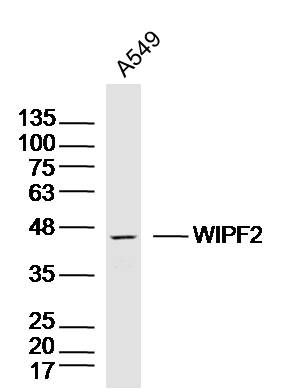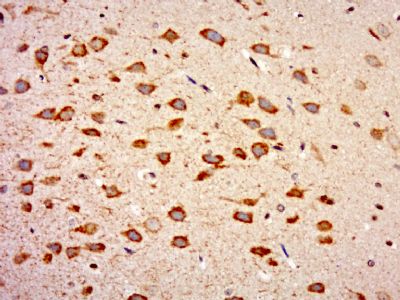WIRE, also known as WIPF2 (WAS/WASL interacting protein family, member 2) or WICH, is a 88 amino acid protein that localizes to both the cytoplasm and the cytoskeleton and contains one WH2 domain. Expressed ubiquitously with highest expression in colon, brain, lung and stomach, WIRE functions as an N-WASP-interacting protein that plays an important role in the organization and mobilization of the Actin cytoskeleton. Additionally, WIRE is involved in the formation of cell surface protrusions and may also provide a link between the cytoskeletal machinery and PDGF-B receptors. Multiple alternatively spliced isoforms of WIRE exist and are encoded by a gene that maps to human chromosome 17.
Function:
Plays an active role in the formation of cell surface protrusions downstream of activated PDGFB receptors. Plays an important role in actin-microspike formation through cooperation with WASL. May cooperate with WASP and WASL to induce mobilization and reorganization of the actin filament system.
Subunit:
Interacts with WASL and WASP, and this interaction results in cytoplasmic relocation of these two proteins along actin filaments. Interacts with NCK2 resulting in the localization to sites of focal adhesions. No interaction was seen with WASF2 and WASF3.
Subcellular Location:
Cytoplasm; cytoskeleton.
Similarity:
Belongs to the verprolin family.
Contains 1 WH2 domain.
SWISS:
Q8TF74
Gene ID:
147179
Database links:
Entrez Gene: 147179 Human
Omim: 609692 Human
SwissProt: Q8TF74 Human
Unigene: 421622 Human
Unigene: 731598 Human
| Picture |
Sample: A549 Cell (Human) Lysate at 30 ug
Primary: Anti- WIPF2 (SL9869R) at 1/300 dilution
Secondary: IRDye800CW Goat Anti-Rabbit IgG at 1/20000 dilution
Predicted band size: 46kD
Observed band size: 46kD
Paraformaldehyde-fixed, paraffin embedded (rat bain); Antigen retrieval by boiling in sodium citrate buffer (pH6.0) for 15min; Block endogenous peroxidase by 3% hydrogen peroxide for 20 minutes; Blocking buffer (normal goat serum) at 37°C for 30min; Antibody incubation with (WIPF2) Polyclonal Antibody, Unconjugated (SL9869R) at 1:500 overnight at 4°C, followed by a conjugated secondary (sp-0023) for 20 minutes and DAB staining
|
|
|

